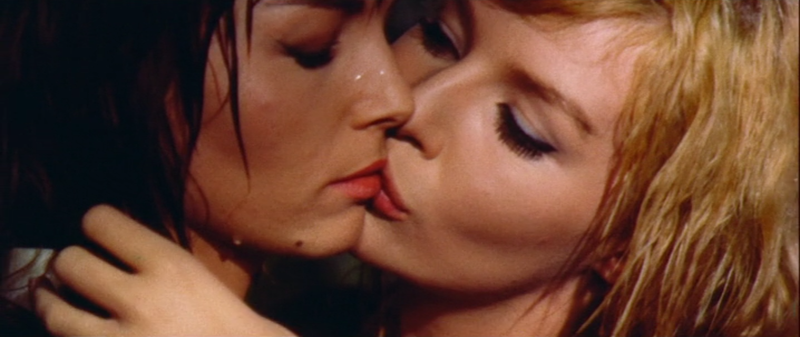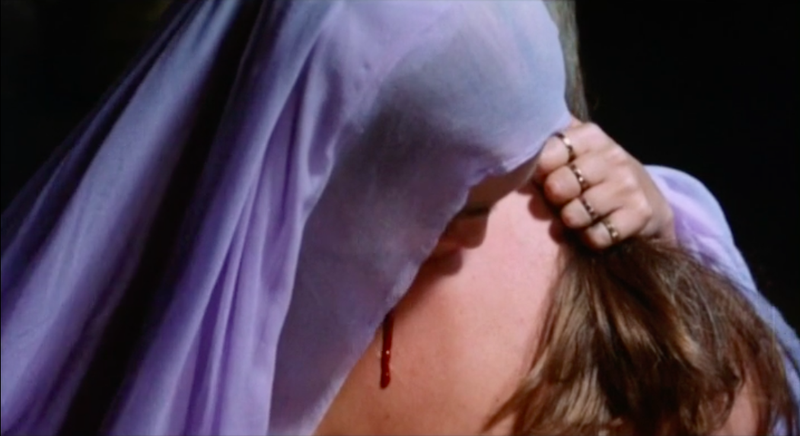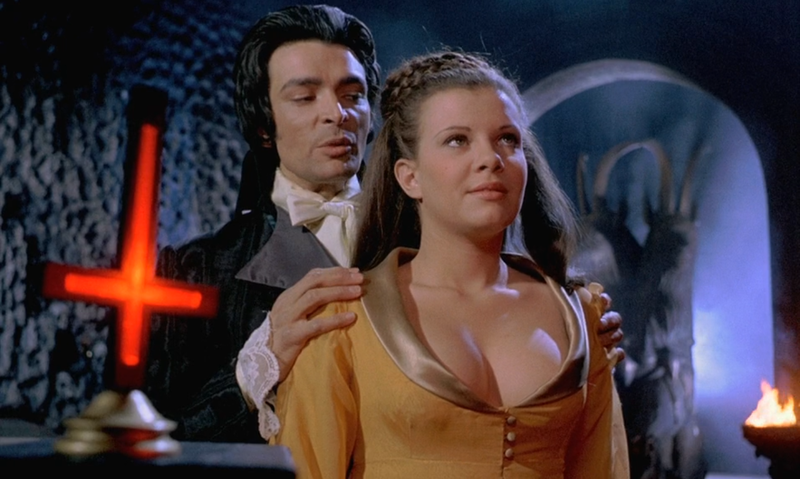Editor's note: Welcome to part two of our four-part Carmilla celebration. If you missed part one, you can get caught up here.
“I had read in old storybooks of such things. What if a boyish lover had found his way into the house, and sought to prosecute his suit in masquerade, with the assistance of a clever old adventuress?”
There’s not a whole lot of plot in Carmilla, so movies based on the book have to invent it. Of all these film adaptations, Emily Harris’ 2019 Carmilla best resists the urge to tack on characters and events, concentrating instead on the twilight aesthetics and languid caresses of Sheridan Le Fanu’s original novella. But even that film adds a governess figure to drive its young lovers, Carmilla (Devrim Lingnau) and Lara (Hannah Rae), apart.
Still, that’s mild compared to the 1989 Nightmare Classics TV movie executive produced by Shelley Duvall, starring Ione Skye as Marie and Meg Tilly as Carmilla. Although it runs a mere 51 minutes, that film still feels the need to fill time with a vampire-hunting subplot, driven by Roddy McDowall doing an exaggerated Southern accent. That ends with Marie accidentally impaling Carmilla on an exceptionally sharp wooden coat rack, rejecting the vampire’s “unnatural” advances and symbolically embracing heterosexuality as she does so. (What else is a wooden stake but a phallic symbol?)

But the nuttiest addition to Carmilla lore has to be from the ultra-low-budget 1998 film The Vampire Carmilla, the rare movie that ends with an apology from the film’s directors to its stars. (As for why, the film is ineptly made and also contains a lot of nudity — which leads one to wonder if the stars felt that baring it all was not, in fact, worth it after viewing the final product.) Now, Blade also came out in 1998. And The Vampire Carmilla’s premise, clearly inspired by the Wesley Snipes movie, is that Carmilla has unleashed a vampire apocalypse that threatens to destroy the world. Which is fine — except for the queer coding of the original novella. Taking that into account, the message of The Vampire Carmilla becomes a cautionary tale, implying that lesbianism is contagious and needs to be eradicated before it overtakes the planet.
Obviously homophobic, right? The idea is more common and appears more recently than one might expect. As late as 2014, the Appalachian indie gothic The Unwanted uses this as a plot point, in the form of a father figure obsessed with the idea that his daughter is “like her mother,” who left him for —you guessed it — a woman named Carmilla. Many scholars have suggested a correlation between the resurgence of lesbian vampire films in the 1970s and ambient panic over the rise of the gay liberation movement in that same decade, much like the link between the rape-revenge cycle and fears of women’s liberation. But looking at adaptations of Carmilla that pre-date the ‘70s, we see similar dynamics at work. This suggests that the fears being subconsciously enacted in these stories have older, deeper roots.
According to the Victorian worldview that informs Carmilla, (white, upper-class), women are a purifying force, holy arbiters of morality that tolerate sex to fulfill their purpose in life by becoming mothers. But this was not always the prevalent belief in European culture. In the novella, it’s implied that Carmilla was born in the 17th century; film adaptations date her back even further, to the early 16th century. Either way, she would have lived during the heyday of the early modern European witch hunts, when the prevailing view on female sexuality was, to quote the infamous 15th-century witch-hunting manual the Malleus Maleficarum, “all witchcraft comes from carnal lust, which is in woman insatiable.”
Awakening a woman’s sexuality could create a monster—one who, in the ultimate breach of hetero-patriarchal norms, might decide that she prefers the arms of another woman to those of her husband after experiencing the dark side of heterosexuality firsthand. This fear repeatedly shows up in Carmilla adaptations and lesbian vampire films more broadly, in the form of bisexual love triangles where a female vampire lures either an engaged or a recently married woman away from her husband. The formula goes something like this: At the beginning of the movie, a heterosexual couple’s happiness is interrupted by the appearance of a mysterious woman, who upsets the “natural” order by seducing the woman and making a cuckold of the man. For this, she must be destroyed.

Aside from Carl Theodor Dreyer’s Vampyr (1932), a very loose adaptation that removes the romantic elements entirely, the French-Italian co-production Blood and Roses (1960) is among the earliest film adaptations of Carmilla — and also a classic example of the bisexual love triangle. In Roger Vadim’s version of the tale, Carmilla (Annette Stroyberg) is a noblewoman from an ancient family who carries a torch for her handsome cousin Leopoldo (Mel Ferrer), who at the beginning of the film arrives at Karnstein Castle with his new wife Georgia (Elsa Martinelli). At first, Carmilla is jealous of Georgia. But before long, she also becomes smitten with her cousin’s bride.
That leads to a scene of Carmilla, supple and elegant and possessed of an otherworldly beauty, kissing Georgia in a lush greenhouse garden bursting with life amid the sound of falling rain. By today’s standards, the moment is quite tame, although it retains its heady sensuality decades later thanks to the jewel-toned cinematography from DP Claude Renoir, nephew of the great French director Jean Renoir. But at the time, a same-sex kiss was only possible in liberal Europe, as the Hays Code, with its ban on depictions of “sexual perversion,” was still in effect in the American film industry in 1960. (Its grasp was loosening by this point, but still.) You can see the difference in the translations: The film’s original French title is Et mourir de plaisir…, which translates as “To Die of Pleasure” — a more provocative title than Blood and Roses.

Blood and Roses keeps its bisexual angst more on the romantic side. But in the 1972 Spanish grindhouse phantasmagoria, The Blood Spattered Bride, heterosexuality is inherently cruel, and vampirism — i.e., lesbianism —is a liberating force that can heal women damaged by sexual violence. (In the movie, this is seen as a bad thing, reflecting the film’s assumed straight male audience.) Maribel Martín stars as Susan, a naive young bride whose groom (Simón Andreu) comes from an aristocratic family with a history of misogynist oppression and a cavalier attitude towards marital rape.
After being sexually assaulted on her honeymoon, Susan becomes obsessed with one of her husband’s ancestors, Mircalla Karnstein, a decadent noblewoman who, according to legend, murdered her husband on their wedding night. Violated, ignored, dismissed, and mistreated, it takes very little for Susan to fall under the spell of a beautiful stranger named Carmilla (Alexandra Bastedo), who, in classic bisexual love triangle fashion, appears midway through the story and inserts herself in the newlyweds’ relationship.
Under cover of darkness, Susan and Carmilla retreat to the ruins of her ancestral castle, where Carmilla acknowledges Susan’s pain. ”Your sanctuary has been ravaged, your tranquility disturbed, your shrine stained, corrupted, grossly invaded by vileness,” she says. Carmilla promises Susan both ecstasy and revenge, telling her that, as fallen women, vampirism is “the only kind of love for you and for me.” She has Susan repeat misandrist phrases — “I hate him,” “he has spat inside my body to enslave me” —before cleansing her of her trauma by biting her on the neck. It’s a scene of ostensible horror that becomes comedic when director Vicente Aranda cuts away to a man eavesdropping on this erotically charged exchange, covering his ears with a pained expression on his face as the women moan in ecstasy. Que horrible!
There’s a sense of guilt in The Blood-Spattered Bride, a feeling that, if women decide to abandon heterosexuality, it will be because of male violence. (That being said, it also posits that male violence is necessary to stop this from happening, so it clearly doesn’t feel that guilty.) On the other hand, Hammer Films’ similarly lurid Karnstein Trilogy has no qualms about imposing male desire onto its lesbian vampires. The Vampire Lovers (1970) is actually one of the more faithful adaptations of the novel; sure, it makes Carmilla into a heartless serial seducer of innocent girls, but as in the book, no men come between Laura and Carmilla — at least, not romantically. Sequels Lust for a Vampire (1971) and Twins of Evil (1971), however, distance themselves to the extent that the credits simply read “based on characters created by J. Sheridan LeFanu.”

Both films retain the gauzy, low-cut nightgowns and styrofoam Gothic aesthetics of The Vampire Lovers but stray from the source material with male protagonists and a bisexual Carmilla. In Lust for a Vampire, Mircalla Herritzen, a.k.a. Carmilla Karnstein, appears as a teenager who falls in love with her much older swinging-bachelor schoolteacher, Richard LeStrange (Michael Johnson). Richard sees her as an innocent who could never harm a soul, but underneath her wide-eyed veneer, Mircalla is a sexually dominant monster who enslaves the school’s timid headmaster before killing her roommate Susan (Pippa Steele). It’s a supernatural spin on a common sexist cliché: The idea that a younger woman involved with an older man must be insatiable, precocious, and “mature for her age.”
By the time we get to Twins of Evil, Carmilla is a minor character in her own story. The primary appeal of the Karnstein sequels is in their kitschy, colorful ‘60s Satanic aesthetics; unlike your stodgier Carmilla adaptations, Twins of Evil buzzes with counterculture energy, pitting youthful vampires against stodgy human adults. But the homoeroticism of earlier installments is almost entirely absent — probably for the best, considering the female protagonists are identical twins. Count (Damien Thomas) and Countess Mircalla Karnstein (Katya Wyeth) appear as vampire swingers building an undead Satanic polycule with black magic, but that’s about it. The camp factor is off the charts, in short, packed with snort-worthy moments like the scene where the camera zooms in from a man and a woman passionately kissing to the woman’s hand stroking a black candle. (Again, the phallic imagery in these stories is rarely subtle.)

But what The Vampire Lovers lacks in male love interests, it makes up for in patriarchal “protectors.” In order to prevent the humiliation of being cucked by a vampire (the de facto subtitle of the bisexual Carmilla films), men have to gather in large numbers to defeat the lesbian menace and return their daughters and wives to the “safety” of heterosexuality. The patriarchal supergroup that assembles to stop Ingrid Pitt’s reign of cleavage terror in The Vampire Lovers is especially irritating (it’s the accents), but, more often than not, an entire posse of upper-class twits —sorry, men of science — is required to defeat Carmilla with manly logic. Never mind that they’re so blinded by their assumptions about women’s sexuality, none of them can figure out that she’s the one who’s been draining innocent maidens for miles around until the end of the movie.
Whether they take the form of oblivious husbands or concerned fathers, Carmilla adaptations that insert men into the narrative always betray the fears and insecurities of the men that made them: Fears of being replaced, inferior, and irrelevant. For queer and bisexual women watching these films, however, they represent something entirely different. These films center on bisexual desire and offer a fantasy of abundance and desirability, presenting a provocative alternative to society’s insistence that hetero- and homosexuality are opposing sides, never to be crossed. These films ask, “why not both?” And if living in that liminal space makes you a monster, so be it. The monsters are better dressed anyway.
Stay tuned for the third installment in this four-part series, coming up next week!






